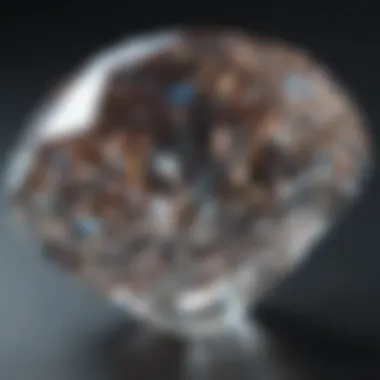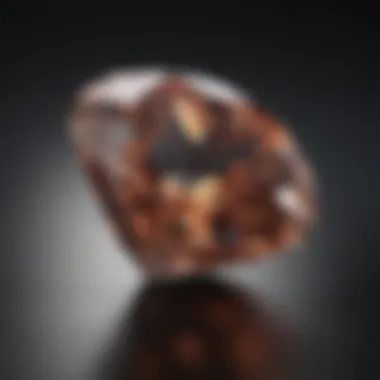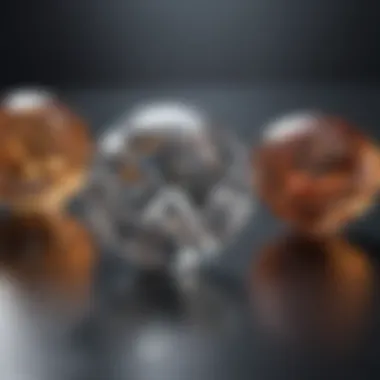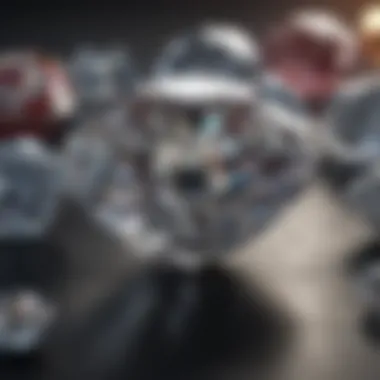Understanding Diamond Carat Weight and Pricing


Intro
Diamonds, often seen as symbols of beauty and wealth, are more than just shiny stones adorning jewelry. At the heart of a diamond's appeal lies the intricate world of carat weight, a metric that carries profound implications for its value and pricing. Understanding this facet of diamonds can not only enrich one’s appreciation but also aid in making informed purchasing decisions. In this article, we will unpack the complexities surrounding diamond carat weight, explore how it interacts with other important aspects like cut, color, and clarity, and discuss market trends that influence pricing.
Gemstone Overview
When diving into diamonds specifically, it’s beneficial to first grasp the broader context of gemstones.
Definition and Characteristics
Diamonds are a type of gemstone made from carbon atoms arranged in a crystal structure. This unique formation grants diamonds their exceptional hardness, making them a favorite for both adornment and industrial applications. High-quality diamonds exhibit remarkable brilliance and fire, resulting from their ability to refract light. The allure of a diamond often brings forth thoughts of elegance, yet its beauty is anchored in precise measurements.
Classification of Gemstones
Gemstones can be divided into two primary categories: precious and semi-precious. Diamonds fall into the precious category, alongside rubies, sapphires, and emeralds. Once we understand the foundation of gemstones, we can narrow our focus back to diamonds. Beyond being categorized as precious, diamonds are often classified by characteristics such as clarity, color, cut, and, most importantly, carat weight. Each of these attributes contributes to their overall value, with carat weight being one of the most significant factors.
Historical Significance
To fully appreciate a diamond's worth and allure, one should also consider its historical context. Diamonds have captivated humanity for centuries, embedded in myths, legends, and cultural narratives.
Ancient Uses and Cultural Importance
Dating back to ancient civilizations, diamonds were not just prized for their beauty but were believed to hold fierce powers of protection and strength. In India, diamonds were regarded as symbols of wealth and were often used in religious ceremonies. Their indestructible nature led many cultures to see them as tokens of eternity, a quality that continues to resonate today.
Myths and Legends Surrounding Gemstones
Interestingly, many cultures have their own myths associated with diamonds, influencing their value and desirability. For example, some believed that diamonds could bring about immense fortune, while others thought they could ward off evil spirits.
"Diamonds are not just stones; they embody history, culture, and significance that exceed their mere physical form."
In summary, understanding the foundations of diamond carat weight begins with recognizing not just the stone itself but its long-standing relationship with society. As we progress, we will delve deeper into how carat weight specifically affects pricing and what savvy consumers should keep close tabs on when considering a purchase.
Prelims to Diamond Carat Weight
When it comes to diamonds, carat weight is more than a mere number; it's pivotal in shaping both the value and allure of the gemstone. Understanding this aspect is essential not just for buyers but also for those immersed in the jewelry industry. Carat weight can greatly influence the overall pricing of a diamond, highlighting its importance in the grand scheme of purchasing decisions. Grasping how carat weight functions in conjunction with other factors, such as clarity and color, can offer a clearer picture of what one is investing in, creating a more informed buying experience.
Definition of Carat Weight
Carat weight is a standard measurement that conveys the size of a diamond. One carat equals 200 milligrams. However, the term 'carat' is often confused with size; two diamonds of the same carat weight can exhibit different dimensions due to varying proportions and cuts. For example, a well-cut diamond might appear larger than a poorly cut diamond of the same carat weight. This nuance is crucial for buyers to recognize, as what matters isn't just the weight but the overall presence and effect of the diamond.
Historical Context of Carat Measurement
The concept of carats has roots tracing back to antiquity when merchants used carob seeds as a counterbalance on scales. These seeds were chosen because of their relatively consistent weight; however, they varied significantly from region to region. The term 'carat' officially became standardized in 1907 at the International Conference on Weights and Measures. Despite its evolution, the historical context serves as a reminder of the evolving nature of trade and the importance of precision in measurements. Knowing this history enriches one's appreciation for the carat as not just a metric but as a legacy of commerce that spans cultures and eras.
The Four Cs: A Comprehensive Overview
In the realm of diamonds, the Four Cs—carat, cut, color, and clarity—serve as the essential pillars that dictate both beauty and value. Understanding these four characteristics isn't merely academic; it's crucial for anyone looking to invest in a diamond. Each aspect interplays in a sophisticated dance that ultimately determines the stone's worth and desirability. As we dissect each C, we’ll uncover the nuances that every discerning buyer should consider.


Understanding Cut Quality
Impact of Cut on Appearance
The cut of a diamond is arguably the most significant of the Four Cs when it comes to its appearance. This is not just about the shape of the stone; it encompasses how well the diamond has been crafted. A well-executed cut can maximize the diamond’s sparkle and brilliance. It's akin to a master chef knowing exactly how to season a dish. A poorly cut diamond, on the other hand, can appear dull, regardless of its carat weight or clarity.
A key characteristic of the cut is its ability to reflect light perfectly. When light enters the diamond, it can bounce around in different ways depending on how skillfully the facets have been arranged. It’s this dance of light that gives diamonds their enchanting quality. A round cut is popularly favored for its superb ability to refract light, making it a beneficial choice for those seeking brilliance.
It’s worth noting, however, that cut quality can be a double-edged sword. A well-cut diamond can command a higher price, but it also dazzles with an intricate play of light that is difficult to find elsewhere.
Popular Cuts in the Market
Popular diamond cuts are numerous, but some stand out due to their timeless appeal and market demand. Cuts like the round brilliant, princess, and emerald shapes continue to capture buyers’ hearts and wallets.
The round brilliant cut, in particular, is a crowd favorite. Its symmetrical shape and optimal faceting mean it often delivers the most sparkle. On the flip side, fancy cuts, such as the pear or marquise cut, can provide a unique aesthetic that some buyers prefer. These distinctive formats have a charm of their own but may not always offer the same level of light return as the round cut.
Understanding the characteristics of these popular cuts is essential for buyers. Each cut can affect the perceived size and brilliance of the diamond, which could ultimately influence purchasing decisions.
Color Grading System
Color Scale Ranges
The color grading system for diamonds is another critical element, ranging from D (colorless) to Z (light yellow). The key here is subtlety; the differences between each grade can be very subtle but still impactful in terms of price and appearance. Color can dramatically influence how light interacts with the stone. Therefore, a diamond graded H is considered near colorless, making it a popular option as a balance between beauty and cost.
Each color grade offers its uniqueness. For instance, diamonds in the G to I range still provide that sought-after spark without breaking the bank, allowing buyers to maximize their budgets while enjoying the visual qualities of a higher-grade diamond.
Influence of Color on Price
Color may seem like a secondary concern compared to cut and clarity, but it wields significant power over price. Diamonds that are closer to colorless often command a premium. This is mainly because most buyers are oblivious to the minor hues present in lower grades. An interesting facet to consider is that yellow tint can sometimes enhance the appearance of larger diamonds, especially in certain cuts, but they're often perceived as less desirable.
Thus, understanding how color plays into the market can assist buyers greatly. Balancing personal preference with budget constraints can lead to more informed purchases.
Clarity and Its Significance
Clarity Grades Explained
Clarity measures the presence of flaws or inclusions within a diamond, graded on a scale from Flawless (no inclusions visible under 10x magnification) to Included (inclusions visible without magnification). A diamond's clarity can significantly affect its overall appearance and, by extension, its price.
The unique feature of clarity grading is its ability to provide a clearer picture of a diamond's internal characteristics. Those who are discerning can often spot imperfections in a lower-quality clarity grade, which can diminish a diamond's appeal. For many buyers, achieving clarity grades of VS1 or VS2 strikes a balance between beauty and value.
How Clarity Affects Value
The significance of clarity can't be overstated; it directly affects the diamond's resale value and perceived quality. While some may prioritize cut and color, a diamond with high clarity often represents a sound investment. Moreover, clarity plays a role in how light travels through the diamond, impacting its brilliance.
Also, it’s interesting to note that the differences among clarity grades can be substantial enough to create noticeable changes in price. A diamond that is graded SI1 (Slightly Included) may appear stunning, but when placed beside a VS2, the latter can shine just a little bit brighter.
Carat Weight and Price Dynamics
Understanding the relationship between carat weight and price is fundamental for anyone delving into the world of diamonds. Carat weight significantly influences diamond pricing, serving as one of the key metrics buyers need to grasp. This section explores this intricate dance between weight, price, and market dynamics, providing insights to navigate purchasing decisions.


Price Scaling with Carat Weight
Weight Affects Price Per Carat
The concept of price per carat is pivotal in the diamond market. As carat weight increases, the price per carat does not simply follow a linear trajectory. Instead, there’s a notable escalation in pricing that reflects the higher demand for larger stones. An interesting aspect about this is that while larger diamonds do cost more, the pricing is often more than just a straightforward addition. The unique characteristic of diamonds is that, as their weight increases, they also tend to become rarer. This rarity reflects on the price.
When you compare a diamond weighing one carat to one that weighs two carats, the price per carat of the two-carat diamond can significantly surpass double that of the one-carat diamond. This showcases the principle of scarcity playing a role in value assessments in this market. The price per carat is a vital element for buyers and collectors looking to invest wisely.
Weight vs. Overall Price Trends
Examining the weight in conjunction with overall pricing patterns provides a broader picture of the diamond market. When looking across time, it becomes evident that price trends fluctuate not only based on individual diamond characteristics but also on economic factors, popular demand, and supply. A noteworthy consideration is this: during periods of economic boom, when consumers are willing to spend more, larger diamonds see a spike in demand and subsequent price increases. On the flip side, when the economy is sluggish, smaller stones may retain better relative value.
Moreover, size preference can shift based on cultural or trend influences. Such fluctuations create what might be termed a 'wave' in pricing, which can cause prices to swing dramatically based on overall market sentiments. It is relevant for buyers to pay attention to these trends to make more informed purchasing decisions.
Market Demand Influences
Sourcing and Availability
The source and availability of diamonds play a major role in shaping prices within the market. Diamonds sourced from different regions often exhibit varied availability due to mining locations, which can lead to regional pricing disparities. The key characteristic here is that certain styles or colors of diamonds may have more limited availability which impacts their market value. For instance, colored diamonds are scarce, and thus are priced higher compared to traditional white diamonds.
Understanding the sourcing dynamics allows buyers to prepare for the eventual price they might pay, knowing that a diamond from a more abundant source will often be more affordably priced compared to one that is rare.
Impact of Trends on Pricing
Trends have a substantial influence on how diamonds are priced. What’s trendy can change based on a multitude of factors including celebrity influence, media coverage, and shifting consumer preferences. For example, specific cuts or colors can become highly coveted based on current fashion or pop culture phenomena. Following such trends gives buyers an edge in both understanding the current market and predicting future values based on what's in demand.
Consumers should remain vigilant to how these trends may impact pricing. If a certain shape or style of diamond becomes a must-have, its price can soar owing to the increased demand. Thus, keeping tabs on industry news and insights can serve well in establishing a keen sense of timing when making a purchasing decision.
Considerations for Buyers
When it comes to purchasing diamonds, understanding carat weight is only part of the equation. Buyers must navigate a sea of choices and financial implications. This section provides insight into what potential buyers should keep in mind to make sound decisions. Whether you are a first-time buyer or an experienced collector, comprehending these elements can significantly impact your purchase experience and satisfaction.
Budgeting for Carat Weight
Setting Expectations
Setting expectations is a crucial aspect of budgeting when considering carat weight. Before you step into a jewelry store or browse online listings, determining your budget can keep you grounded. It allows you to narrow down your choices and avoid being influenced by dazzling options beyond your reach. A key characteristic of this process is aligning your financial capabilities with your desires. This alignment fosters a clearer perspective on what you can realistically afford.
Setting a well-defined budget not only aids in decision-making but also helps you filter out the temptations of larger or more expensive stones that may catch your eye. One unique feature of this approach is its direct influence on the emotional engagement of the buying process. While it may seem restricting at first, setting boundaries can lead to greater satisfaction, as the focus turns to making informed choices instead of being swept away by the sparkle. However, the downside can be the constant reminder of preferences that must be set aside, making it essential to strike a balance between practicality and desire.
Value vs. Emotional Significance
When considering a diamond, buyers often grapple with the dichotomy between financial value and emotional significance. Understanding this aspect is vital for a more fulfilling purchase. The value of a diamond often hinges on its carat weight, cut, clarity, and color — metrics that can be objectively assessed. However, the emotional significance of a stone, such as the memories attached to it or the feelings it evokes, can’t be quantified in numbers. This topic is a drawing point in the diamond buying process.
One key characteristic here is that while the market dictates prices, the sentiment attached to an item can far outweigh its monetary value. Often, buyers find that smaller stones purchased for sentimental reasons carry more weight in their hearts than larger stones bought merely for status. This unique feature illustrates the dilemma faced by many buyers: Should one focus solely on the investment aspect, or does the emotional significance take precedence? Balancing these two factors can certainly impact a buyer’s experience and satisfaction.
Choosing the Right Carat Weight
Choosing the right carat weight requires careful consideration of several factors. It's not merely about choosing the largest stone within your budget but rather finding that sweet spot where aesthetics meets affordability. Potential buyers must reflect on what they want in a diamond and how that aligns with their lifestyle.


Smaller Stones vs. Larger Stones
In the world of diamonds, the debate over smaller stones versus larger ones is not just about carat weight; it’s about personal preference and practicality. Many buyers find that larger stones often command much higher prices, yet they may not offer a proportionate increase in visual impact. The allure of a hefty carat can often cloud judgment, leading to purchases that lack personal significance or style.
Smaller stones can be an attractive alternative. Not only are they generally more affordable, but they also provide flexibility in design and setting options. For example, a cluster of smaller stones can create a stunning visual effect that some larger stones cannot match. A downside may include an underwhelming presence in certain lighting or settings; yet, many argue that when styled correctly, smaller stones can shine just as bright. Ultimately, knowing what you value in the aesthetic presentation of a diamond is pivotal.
Balancing Appearance and Price
Balancing appearance and price when choosing diamond carat weight brings complexity to the buying process. This involves a careful assessment of how each choice impacts both your wallet and the look you desire. A key characteristic is understanding that a higher price doesn’t always equate to a more visually impressive diamond. The cut quality, clarity, and overall design of the ring can likewise affect how a diamond appears when worn.
This balancing act often requires buyers to weigh their priorities. Do you want a larger carat that lacks in clarity, or would you prefer a smaller carat that is flawless? The interplay between carat weight, visual appeal, and pricing can lead to strategic choices that reflect both personal taste and financial considerations. It’s crucial to explore various options, educate oneself about the nuances of diamond grading, and ask questions before settling on a final choice.
"In every diamond purchase, one must find harmony between the emotional allure of the gem and the reality of the price tag. This delicate balance can usher one towards a decision that not only satisfies the desire but also respects the budget."
Navigating the considerations for buyers can empower consumers, giving them the knowledge needed to make decisions that reflect their individual needs and desires.
Educational Resources
When it comes to navigating the diamond industry, knowledge is power. Understanding the complexities of carat weight and its relationship with pricing becomes vastly easier when one has access to reliable educational resources. These resources offer insights that can help enthusiasts, collectors, and jewelry designers make well-informed decisions. They break down intricate concepts into digestible formats, ensuring that the buyer is equipped with the tools needed to interpret market trends and pricing dynamics effectively.
Reputable Jewelers and Vendors
Finding trustworthy jewelers and vendors is crucial in any diamond purchase. Not all jewelers are created equal; the market is filled with both reputable names and those who may not have the buyer's best interest at heart. Engaging with acknowledged industry players is essential because they adhere to ethical practices and supply high-quality stones.
When looking for a reputable vendor, consider the following factors:
- Certification: Always check if the diamonds come with certification from reputable grading institutions like the Gemological Institute of America (GIA) or the American Gem Society (AGS). This certification ensures that the stone's attributes, including carat weight, cut, color, and clarity, are accurately represented.
- Transparency: Reputable jewelers should be forthcoming about their sourcing methods, pricing structures, and return policies. If they offer a no-questions-asked return policy, it often signifies confidence in their product.
- Customer Reviews: Reviews and testimonials can provide insight into customer satisfaction. Researching online reviews or asking for referrals can lead you to trustworthy jewelers.
In this digital age, brick-and-mortar shops are not your only options. Many reputable online vendors offer a vast selection of diamonds. They often provide detailed photographs and video of stones, which help in gauging quality. Consider vendors like Blue Nile and James Allen, which have developed significant trust with consumers over the years. However, always do ample scrutiny regardless of where you're buying.
Industry Publications and Research
Industry publications and research play a vital role in staying current with trends and best practices in the diamond market. They provide critical insights that help decipher the implications of carat weight on pricing, among other factors. Accessing these resources can equip buyers with information regarding current market demands and potential price shifts.
The following types of resources can be particularly beneficial:
- Trade Magazines: Publications like JCK and National Jeweler provide analysis on the diamond market's performance, trends in consumer preferences, and techniques for effective pricing strategies.
- Academic Journals: Research papers focusing on gemstones often present experimental findings tied to market behaviors and consumer psychology. This research contributes to a more profound understanding of what influences value determination in diamonds.
- Online Forums and Communities: Platforms like Reddit and specialized Facebook groups are valuable for real-time consumer opinions and experiences regarding purchasing diamonds. Die-hard collectors often share firsthand accounts, which can serve as excellent educational material alongside professional publications.
Utilizing reputable educational resources, whether through jewelers, vendors, or industry publications, can empower buyers. With this knowledge in hand, prospective buyers can confidently navigate the mosaic of diamond purchasing, making choices that resonate with their fiscal capabilities and aesthetic desires.
The End
When delving into the realm of diamonds, understanding carat weight and its impact on price emerges as a fundamental pillar. It’s not just about the numbers; it’s a dance of factors that influence value, aesthetics, and consumer decisions. Knowledge of how carat weight interacts with other characteristics—such as cut, color, and clarity—equips buyers with the tools to navigate their choices more effectively.
Summary of Key Points
- Carat Weight Matters: Heavier stones can command higher prices, but it's crucial to recognize that this isn't the only determinant.
- Interplay with Other Cs: Cut, color, and clarity work hand-in-hand with carat weight to create a comprehensive picture of a diamond’s value. A diamond might be larger but if its cut is compromised, it may not shine as brightly.
- Market Influences: Demand trends and supply availability fluctuate, impacting pricing dynamics unexpectedly. Market savvy buyers are those who stay informed about these trends.
- Emotional Significance: Beyond monetary value, the emotional aspect of a diamond purchase can significantly tilt decision-making. The connection one has with a particular stone often transcends just its weight.
Final Thoughts on Diamond Purchasing
Purchasing a diamond is more than merely selecting based on carat weight; it involves understanding what you value most—be it size, brilliance, or sentiment. Whether you're a collector seeking the best carat-to-value ratio or someone aiming for that perfect engagement ring, each decision matters.
Consider factors like certifications and sourcing, as they add layers of trust and authenticity to your purchase. Moreover, explore reputable jewelers who can provide expert guidance tailored to your needs. Engaging in conversations on industry platforms, such as reddit.com, can also provide insights you might not find elsewhere.
Above all, remember that the beauty of a diamond doesn’t solely rest on its carat weight; sometimes, the most stunning pieces are those that resonate with the heart. Invest in knowledge, seek transparency, and carry the essence of what those stones represent into the joyous moments they are intended to celebrate.







